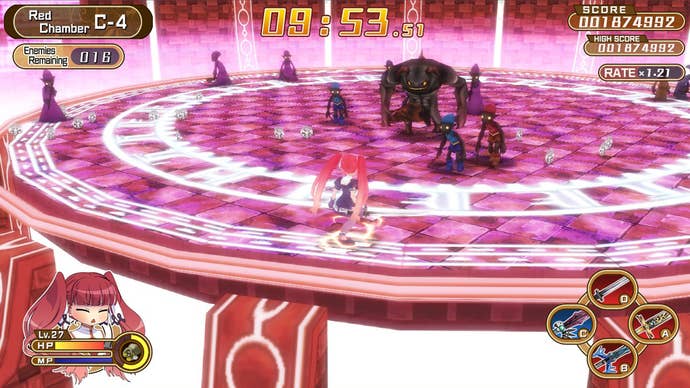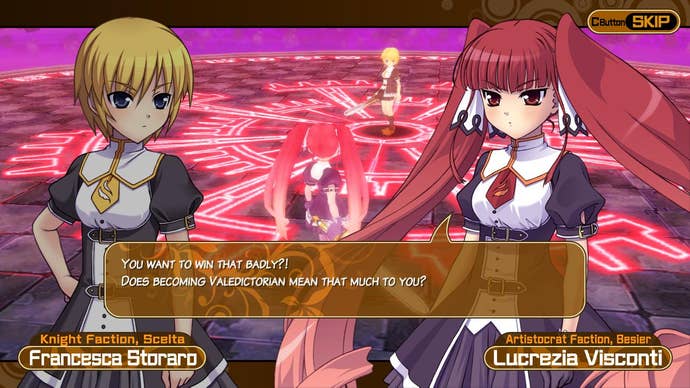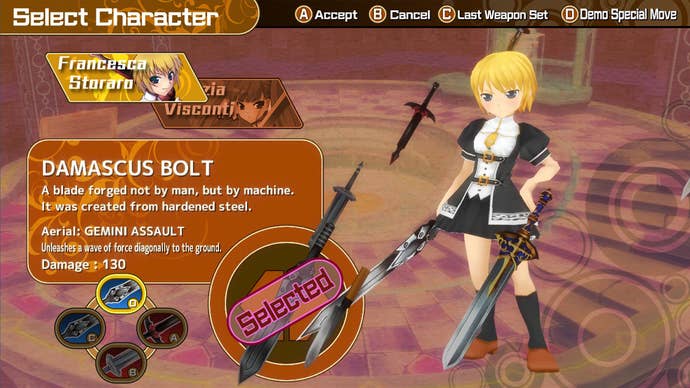Croixleur Sigma PC Review: Hack, Slash, Dash
Nyu Media's latest localized doujin title is a joyful hack-and-slash affair. But is there any meat on the bones?
This article first appeared on USgamer, a partner publication of VG247. Some content, such as this article, has been migrated to VG247 for posterity after USgamer's closure - but it has not been edited or further vetted by the VG247 team.
"Haaaah... haaaahhh... haaaahhh..." (pause) "Haaaah... haaaahhh... haaaahhh..." (pause) "Haaaah... haaaahhhh... haaaahhh..."
No, it's not the subtitles to a saucy scene in a visual novel, it's what you'll more than likely be hearing when you first start playing Croixleur Sigma, the barely-pronounceable indie-developed Japanese arcade-style hack-and-slash title from Souvenir Circ, lovingly brought to the West by doujin specialists Nyu Media.
The sound is protagonist Lucrezia unleashing her three-hit combo over and over again. There's no change each time you do it, so if you just keep hammering the "attack" button over and over again, you will indeed hear nothing but "Haaaah... haaaahhh... haaaahhh..." (pause) "Haaaah... haaaahhh... haaaahhh..."

That is, until you discover the "dash" button, at which point the sound emanating forth from your speakers becomes more like "Haaah... haaaahhh... WHOOSH... haaaah... WHOOSH... haaah... FWIP! haaah haaah haaaah!" punctuated by your own gleeful laughter at the sheer fluidity of the on-screen action. It's at this point that Croixleur Sigma stops being a seemingly mediocre arena-based hack-and-slash title with an apparently limited moveset, and becomes something with all the style, precision and pure joy of a top-tier Japanese console or arcade game.
Croixleur is one of those games that initially seems pretty simple and, surprisingly, actually isn't all that much more complicated than first appears. Once you've got the hang of "cancelling" moves into one another, allowing for fluid, uninterrupted chains of attacks, dashes, jumps and special moves, you know everything you need to know to play the game well. The challenge, of course, then comes in knowing how to use these simple mechanics effectively, and how not to waste your limited magic points resource which powers some of these moves.

Each level seems like a fairly random swarm of enemies, but they're set up in such a way as to encourage you to visualize "paths" through your foes. It's something you'll find yourself doing naturally before long, and it's here that what initially seems to be a limitation of the game -- a small selection of palette-swapped enemies rather than more unique foes -- actually becomes a key feature. The game's simple presentation gives you a handy visual shorthand as to enemies' strengths and capabilities, and by recognizing the combination of silhouette and color you'll be able to plan your moves several steps in advance: "Hmm... yellow enemies only take one hit, but the tall ones have a ranged attack, so I'll attack that one, dash to that one, jump up and hit that flying one, mid-air dash to that purple flying one, which needs two hits, stomp down onto the one below it and finally use a special move on that red one that takes more hits to kill."
Of course, there's nothing stopping you from just button-mashing your way through and indeed with the generous Continue system pretty much anyone will be able to make it to the end of the 15-minute Story mode. As any dedicated player of Japanese arcade-style titles will tell you, though, the true joy of these games comes from attempting to "1CC" (1 Credit Clear) the game, and from there attempting to better your own high score through mastery of the mechanics: in this case, unbroken kill chains and avoiding damage. Croixleur Sigma caters ably to this type of perfectionist player not only through the story mode, which rewards you for completing it more quickly and efficiently with unlockable content (including a new playable character), but also through dedicated game modes. Score Attack, for example, provides you with three minutes to hack and slash your way through as many enemies as possible and rack up a big score, while Survival instead features a timer that counts up, not down, challenging you to last as long as you can. Challenge Mode, meanwhile, provides you with a selection of short, ten-second tasks that will really test -- and train -- the skills you'll need for success in the other modes. Couple all that with a two-player (local only) cooperative mode and you have a surprisingly comprehensive package that will keep arcade fans coming back for more time and again.

There's a few niggling little flaws that mar the experience a little, though. There's Steam leaderboard support, but it's not integrated into the game -- or if it is, I couldn't find it -- meaning you can only browse your local high scores without opening the Steam client. Even then, global scores aren't in a particularly obvious place -- you have to go to Achievements first, then pick a leaderboard to view. It would have been nice to see some tighter Steamworks integration.
Japan's failure to adopt the Xbox 360 pad as the "standard" also means that the game's controller support isn't what it could be, either; buttons are labelled A, B, C and D rather than A, B, X and Y, meaning you'll have to remember which button does what. Thankfully, the first time you boot the game up with a controller connected it invites you to configure whatever controller you have to hand with a recommended layout, meaning you can rely mostly on muscle memory. Be prepared to deal with Japan's habitual swapping of the "accept" and "confirm" buttons compared to what we usually use in the West, though; using a standard 360 controller and the recommended layout, "confirm" is mapped to B rather than the more common A.
The graphics are decent quality and move along at well over 60 frames per second on fairly modest hardware, but a lack of VSync options mean that certain displays -- most notably TVs -- will suffer a certain degree of screen tearing as the camera moves around. I've seen far worse tearing (hello, Uncharted) and it certainly doesn't make the game unplayable, but it is noticeable and disappointing that the option to eradicate it doesn't appear to be there.

Finally, some players may feel that the game is lacking in content. You can beat the story mode in 15 minutes and, assuming you're a skilled player, unlock all the content within a few hours. Some may stop there, but others may continue playing in an attempt to best their own high scores. The latter option, much like other Japanese arcade-style games such as danmaku shooters, is how the game is clearly intended to be played, but it perhaps wouldn't have hurt to have a little more variety in the game -- in terms of enemies and level layouts in particular.
These issues aside, Croixleur Sigma is an enjoyable -- and cheap! -- game particularly suited to having in your Steam library for when you have a few minutes to spare and just want to hack a few things to pieces. Its quick play sessions and straightforward mechanics make it a simple game to pick up but, as the old saying goes, a hard one to master -- and there's enough depth there for hardcore score-chasers to while away hours at a time.
Haaah... haaah... haaahhh...
The Nitty Gritty
- Visuals: Character designs and 2D art are really nice; enemy designs are a bit drab, and there aren't many of them. The whole thing runs at a beautifully slick frame-rate, though some screens will have screen-tearing issues.
- Music and Sound: The music is fun and catchy; sound effects do their job nicely, providing additional feedback on top of the clear visuals.
- Interface: Lack of native 360 controller support is a shame, but once you've configured your pad with an appropriate layout everything is within easy reach.
- Lasting Appeal: If you're a "once and done" gamer, there's not much for you here. If you enjoy score attack and 1 Credit Clears, though, this will keep you busy for a good few hours.
ConclusionA solid arcade hack-and-slash with easy-to-understand, hard-to-master mechanics.
